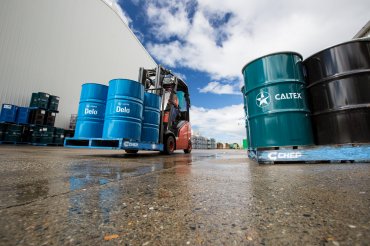The number of lubricant blending plants in Australia continues to shrink. High expenses for imported raw materials, rising labor costs and advantages for production in Southeast Asia have all been blamed for the trend.
Shell is the latest firm to shed lube manufacturing facilities. The energy giant agreed in February to sell its downstream operations in Australia to Swiss energy trader Vitol, but blending and grease plants in Geelong are not included in the transaction and will be converted to warehousing within 11 months. This follows the closure of a number of Australian-owned blending plants during the past decade.

Photo courtesy of Caltex Australia
Lubricants being stored at ALMC’s blending plant in Lytton, Australia.
Some observers have raised questions about the fate of plants operated by Australias largest lubricant blender, Australasian Lubricant Manufacturing Co. Co-owners BP and Caltex plan to dissolve the joint venture – which runs plants in Lytton, Newport and North Fremantle – in 2015. The Lytton plant will revert to Caltex, which said it actually plans to invest in the facility. BP, which inherits the other two plants, said in January that it wanted to develop an agile supply chain but that it did not believe that there will be a need for significant imports….
Stephen B. Ames, principal of U.S. consulting firm SBA Consulting, speculated that one or more of the plants will be sold and some blending operations transferred overseas. The dissolution of the joint venture would indicate that one or both partners have changed their needs for local blending and/or equity in local blending assets, he told Lube Report Asia.
Industry pundits say Australian blending is declining purely because of economics and parallels the broader demise of the countrys manufacturing sector, according to head of Lubricant Specialists Australia, Mark Quackenbush.
Only a few small blenders remain, he said. As a consequence, were experiencing an increase in the number of imported brands being offered.
Australias market has a heavy emphasis on the automotive segment, which comprises about three-quarters of the countrys 440,000 ton per year demand, according to Ames. He identified a handful of remaining independents still blending on Australian soil, including Tru-Blu Oil, Penrite, TriTech, Otech Australia, Gulf Western Oils and Nulon.
The decline in number of blending plants has accompanied the complete elimination of virgin base oil plants in Australia. The countrys last three plants closed during the past decade, the final one being Chevrons facility in Kurnell in 2011.
When announcing its closure, Chevron said Australias lubricating oil market had developed substantial demand for higher quality engine oils that perform at higher temperatures and last longer between oil changes.
Other than a few small rerefining operations, there are no indigenous base oils produced in Australia since the closure of Chevrons Kurnell plant, Ames said. Nor are additives produced in Australia.
Labor costs have also increased in Australia over the past decade, primarily on the back of the strong Aussie dollar. Geography also works against the economies of local blending, with vast distances between major demand centres, Ames explained.
Australian cabotage laws require the use of high-cost Australian flag and crewed vessels for movement of goods – including base oil, additives and finished lubricants – from one Australian port to another, he said. All of the lubricant raw materials have to be imported, mostly from Southeast and East Asia, as well as the U.S. Bulk freight costs are high as Australian ports are considered diversions from normal global trade routes.
It costs a lot less to blend and supply finished lubricants from large blend centers self-sufficient in base oils and additives that have access to low-cost freight logistics. Singapore has benefitted from the closure of Australian blend plants, he said.
The major lubricant marketers in Australia – BP, Shell, ExxonMobil and Chevron – all have large efficient blend plants in Singapore. To them, the transfer of their Australian volumes is an incremental cost, whereas maintaining their Australian blending presence remains a higher total cost option.
Logistics from Singapore, one of the largest ports in the world, are also favorable. Packaged lubricants shipped in containers using international carriers can reach many Australian ports at lower cost than from the few, far-flung domestic blend plants, Ames said.
Australian independent Phoenix Lubricants has imported product from Singapore for many years, according to director Sonja Boric.
Our industry here in Australia is not regulated, therefore allowing variations, which result in poor quality products. But consistency and quality are always a high priority for us, she said. Too many local manufacturers use line flushings. Many of our products carry OEM approvals, not available via local manufacturers. Major oil companies will not entertain selling to independents; our volumes are too small, and their turnaround too slow. Or, they simply price products too high. Independents are just a thorn in their side.
But the blend market isnt likely to disappear altogether, observers say.
A demand for locally blended lubricants is likely to remain, especially for the industrial sector. Industrial lubricants have a much lower additive content, and many can be blended with locally produced rerefined oils, Ames said. He added that industrial customers usually require higher service levels more easily provided by local blending facilities.
Annie Hanafin, a management consultant on the lubricants industry for U.K.-based Malik Pims, has worked with a few Australian blenders. She agrees there is a reasonable market for specialty blenders due to the large amount of industrial activity in Australia.